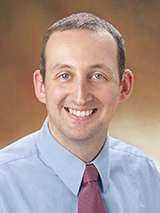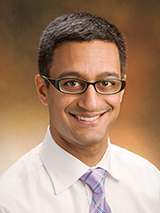On Dec. 4-5, Children’s Hospital of Philadelphia’s (CHOP) Center for Pediatric Airway Disorders participated in the Society for Ear, Nose and Throat Advancement in Children (SENTAC)/Aerodigestive Society 2020 Virtual Meeting. Three of our prominent doctors and one of our voice therapists were able to share their expertise.

The two societies combined their annual meetings for the 1st time to create an international forum to exchange ideas to improve the health and lives of children with aerodigestive, hearing, speech and swallowing, and otolaryngology disorders. Attendees of the 2020 virtual conference included providers in otolaryngology, audiology, speech language pathology, pulmonology, and gastroenterology.
Joseph Piccione, DO, MS, attending pulmonologist and the Pulmonary Director of the Center of Pediatric Airway Disorders at CHOP, and Luv R. Javia, MD, attending physician in the Division of Otolaryngology and the Center for Pediatric Airway Disorders, participated in a panel titled Minimizing COVID Risk to the Healthcare Worker.

COVID-19 aerosolization is a significant concern in both the pulmonary and otolaryngology fields due to the nature of the diagnostics, treatments, and procedures involved to provide care to children. Dr. Piccione and Dr. Javia shared their experience in insuring quality safe care for provider engagement with their patients. Dr. Piccione reviewed CHOP’s Division of Pulmonary’s protocols both in the outpatient and inpatient setting. Highlights included determining when to use PCR testing, focused screening questionnaires, spacing appointments so families are brought directly to the exam room and how they determined what type of PPE to use for different situations. A unique CHOP approach for PPE Dr. Piccione discussed was the benefit of having individuals monitor the placing on and doffing of PPE. This reduced any errors that could occur, especially in the operating room. Dr. Javia presented the various measures ENT developed in conjunction to CHOPs standardize hospital safety policies, including simulation with OR staff in determining perioperative management strategies and the creation of a surgical “tent” with disposable drapes. He discussed how key CHOP’s creation of an in-house COVID-19 PCR testing and the reprocessing of N95s were instrumental in ramping up surgical cases. Both physicians stressed the benefits of telehealth providing the examples of performing speaking valve trials at home or upsizing a tracheostomy at home with a nurse practitioner on the visit.
Dr. Matthew Ryan, attending in the Division of Gastroenterology and part of the Center for Pediatric Airway Disorders, shared his experience in establishing a transnasal endoscopy practice. A procedure that was established at Children’s Hospital of Colorado, Dr. Ryan spoke of the benefits he saw bringing the procedure at CHOP in light of the number of aerodigestive and eosinophilic esophagitis, and esophagitis patients that need repeat EGDs. The procedure involves no anesthesia, rather the child is distracted by the child can watching a program via virtual reality goggles. The provider threads the scope through the nose and able to obtain the same samples as if they were in the operating room. The actual procedure is 6 minutes long. With few program in the country, it is exciting that CHOP is able to provide this service.
Paula Barson, CCC-SLP, a voice therapist with the Pediatric Voice Program, participated in the panel “Feeding-Swallow and Voice Considerations in CHD Patients: SLP/ENT Collaborative Approach”. Drawing from her experience with cardiac patients who develop voice issues, Paula shared the evaluation and analyzation of the voice during clinic, including the pre and post-operative results from a recurrent laryngeal nerve reinnervation. CHOP’s Dr. Karen Zur, Director of the Pediatric Voice Program and Chief of Otolaryngology, has performed the largest number of pediatric recurrent laryngeal nerve reinnervations. Paula reviewed the successful results of this procedure from the voice and feeding standpoint, both clinically and objectively. The Center for Pediatric Airway Disorders was grateful for the invitations to participate and share the CHOP experience.
Featured in this article
Specialties & Programs
On Dec. 4-5, Children’s Hospital of Philadelphia’s (CHOP) Center for Pediatric Airway Disorders participated in the Society for Ear, Nose and Throat Advancement in Children (SENTAC)/Aerodigestive Society 2020 Virtual Meeting. Three of our prominent doctors and one of our voice therapists were able to share their expertise.

The two societies combined their annual meetings for the 1st time to create an international forum to exchange ideas to improve the health and lives of children with aerodigestive, hearing, speech and swallowing, and otolaryngology disorders. Attendees of the 2020 virtual conference included providers in otolaryngology, audiology, speech language pathology, pulmonology, and gastroenterology.
Joseph Piccione, DO, MS, attending pulmonologist and the Pulmonary Director of the Center of Pediatric Airway Disorders at CHOP, and Luv R. Javia, MD, attending physician in the Division of Otolaryngology and the Center for Pediatric Airway Disorders, participated in a panel titled Minimizing COVID Risk to the Healthcare Worker.

COVID-19 aerosolization is a significant concern in both the pulmonary and otolaryngology fields due to the nature of the diagnostics, treatments, and procedures involved to provide care to children. Dr. Piccione and Dr. Javia shared their experience in insuring quality safe care for provider engagement with their patients. Dr. Piccione reviewed CHOP’s Division of Pulmonary’s protocols both in the outpatient and inpatient setting. Highlights included determining when to use PCR testing, focused screening questionnaires, spacing appointments so families are brought directly to the exam room and how they determined what type of PPE to use for different situations. A unique CHOP approach for PPE Dr. Piccione discussed was the benefit of having individuals monitor the placing on and doffing of PPE. This reduced any errors that could occur, especially in the operating room. Dr. Javia presented the various measures ENT developed in conjunction to CHOPs standardize hospital safety policies, including simulation with OR staff in determining perioperative management strategies and the creation of a surgical “tent” with disposable drapes. He discussed how key CHOP’s creation of an in-house COVID-19 PCR testing and the reprocessing of N95s were instrumental in ramping up surgical cases. Both physicians stressed the benefits of telehealth providing the examples of performing speaking valve trials at home or upsizing a tracheostomy at home with a nurse practitioner on the visit.
Dr. Matthew Ryan, attending in the Division of Gastroenterology and part of the Center for Pediatric Airway Disorders, shared his experience in establishing a transnasal endoscopy practice. A procedure that was established at Children’s Hospital of Colorado, Dr. Ryan spoke of the benefits he saw bringing the procedure at CHOP in light of the number of aerodigestive and eosinophilic esophagitis, and esophagitis patients that need repeat EGDs. The procedure involves no anesthesia, rather the child is distracted by the child can watching a program via virtual reality goggles. The provider threads the scope through the nose and able to obtain the same samples as if they were in the operating room. The actual procedure is 6 minutes long. With few program in the country, it is exciting that CHOP is able to provide this service.
Paula Barson, CCC-SLP, a voice therapist with the Pediatric Voice Program, participated in the panel “Feeding-Swallow and Voice Considerations in CHD Patients: SLP/ENT Collaborative Approach”. Drawing from her experience with cardiac patients who develop voice issues, Paula shared the evaluation and analyzation of the voice during clinic, including the pre and post-operative results from a recurrent laryngeal nerve reinnervation. CHOP’s Dr. Karen Zur, Director of the Pediatric Voice Program and Chief of Otolaryngology, has performed the largest number of pediatric recurrent laryngeal nerve reinnervations. Paula reviewed the successful results of this procedure from the voice and feeding standpoint, both clinically and objectively. The Center for Pediatric Airway Disorders was grateful for the invitations to participate and share the CHOP experience.
Contact us
Center for Pediatric Airway Disorders